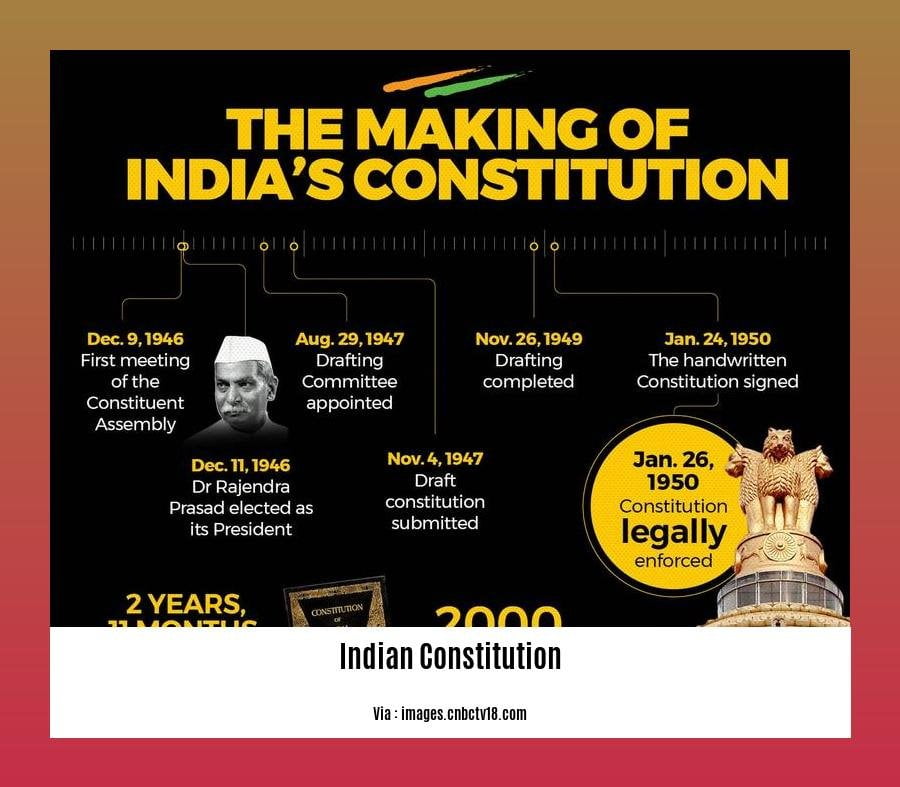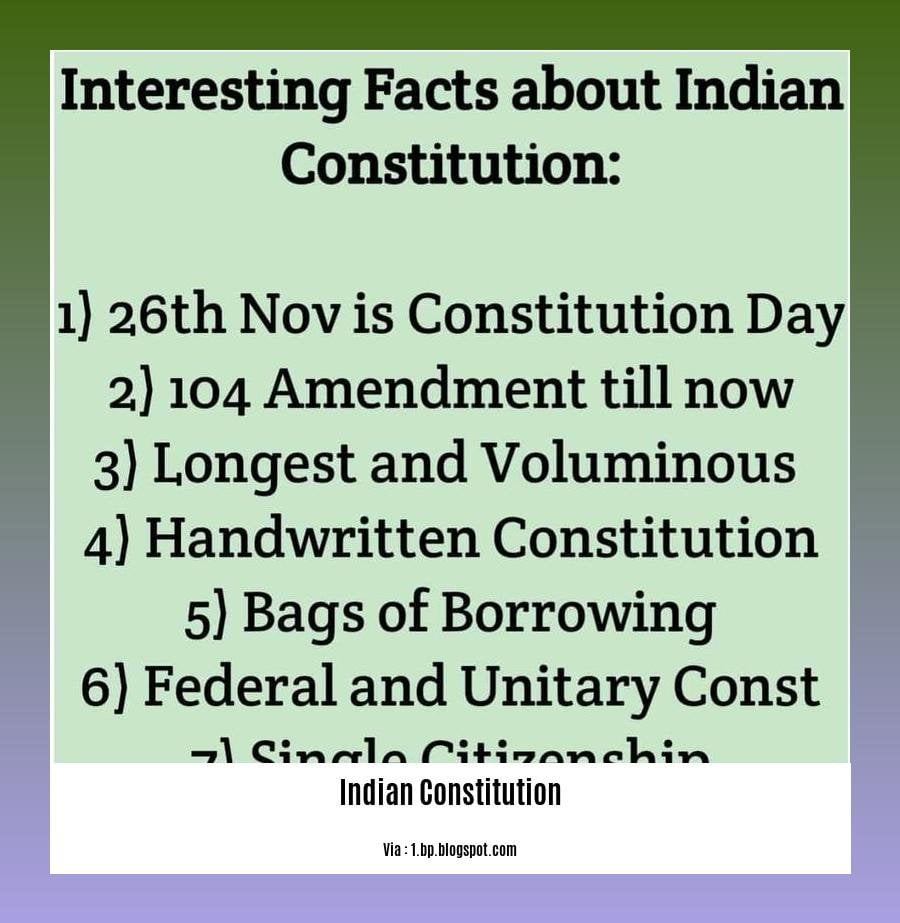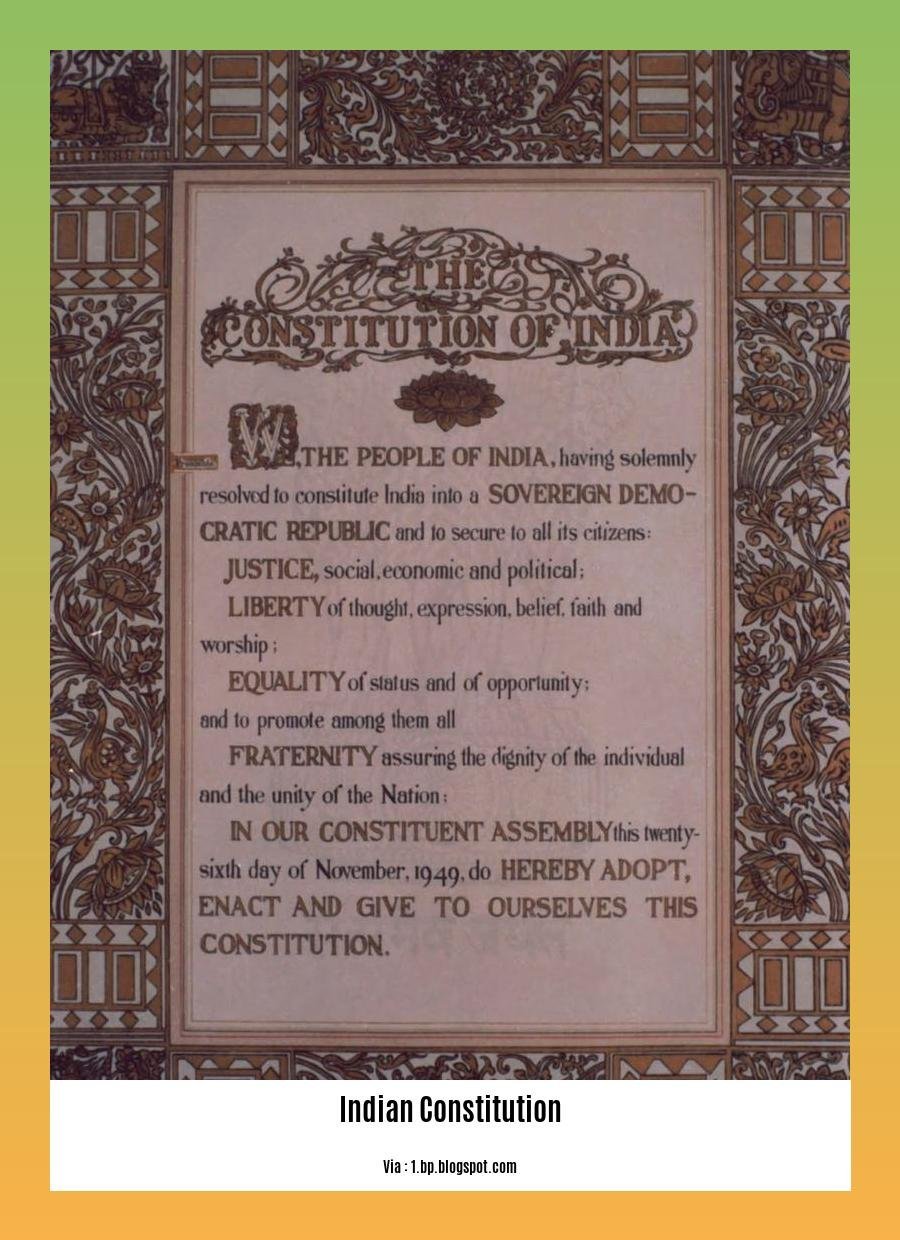Unearthing the Humorous Gems: Funny Facts About the Indian Constitution
Discover the fascinating and delightful world of the Indian Constitution with a twist of humor. In this article, we delve into the funny quirks and unexpected anecdotes that make our constitutional framework truly unique. From peculiar provisions to amusing historical anecdotes, join us as we unearth the humorous gems hidden within the Indian Constitution. Whether you’re a political enthusiast, a curious citizen, or simply seeking a lighthearted read, get ready to be entertained and enlightened by the funny facts that shape our nation’s governing document.
Key Takeaways:
- The Indian Constitution is the longest constitution in the world, consisting of a Preamble, 22 parts, 448 articles, 12 schedules, 5 appendices, and 115 amendments.
- The original copies of the Indian Constitution were handwritten in Hindi and English by Prem Behari Narain Raizada, with each page beautifully decorated by artists.
- The Indian Constitution was influenced by elements taken from 10 different countries.
- Dr. Bhimrao Ambedkar, the first Law Minister of Independent India, played a significant role in drafting the constitution.
- 284 members of the Constituent Assembly signed the Indian Constitution after extensive discussion and debate.
- The English version of the constitution contains approximately 117,369 words.
- India became a democracy on January 26, 1950, when the constitution came into effect, shaping Indian democracy and defining the rights of its citizens.
Funny Facts About the Indian Constitution

Let’s dive into the world of the Indian Constitution, a document that encompasses the hopes, dreams, and aspirations of millions of people. But who said that a constitution can’t have its fair share of humor? Brace yourself as we unearth some hilarious and lighthearted gems hidden within the Indian Constitution!
1. A Magnum Opus of Wordiness
Ever wondered why the Indian Constitution is often referred to as the longest constitution in the world? Well, hold on to your seats because this quirky fact is sure to leave you flabbergasted! The Indian Constitution consists of the Preamble, 22 parts, 448 articles, 12 schedules, 5 appendices, and a whopping 115 amendments. Phew! With such an abundance of content, it’s no wonder this constitution is truly a verbose masterpiece!
2. A Stroke of Artistic Ingenuity
Prepare to be amazed by the artistic touch of the Indian Constitution. Unlike the mundane printed or typed constitutions, the original copies of the Indian Constitution were handwritten by a talented calligrapher named Prem Behari Narain Raizada. To add an aesthetic flair, each page of the constitution was adorned with beautiful illustrations created by renowned artists. Who said the law can’t be a work of art?
3. A Tapestry of Global Inspiration
Did you know that the Indian Constitution has borrowed elements from various countries? It’s true! This unique document has taken inspiration from not one, two, or three but a whopping ten different countries. From the United States to Germany to Australia, the Indian Constitution weaves together aspects of governance and justice from different corners of the world. Talk about globalization at its finest!
4. The Herculean Efforts of Dr. Ambedkar
At the heart of this constitutional masterpiece lies the sheer dedication and brilliance of Dr. Bhimrao Ambedkar, the first Law Minister of Independent India. With his unwavering commitment and expertise, Dr. Ambedkar played a significant role in the drafting of the Indian Constitution. His contributions have left an indelible mark on India’s democracy, making him a true hero in the world of constitutional affairs.
5. A Deliberative Odyssey
Before being forever engraved in history, the Indian Constitution went through an extensive process of discussion and debate. Can you just imagine the heated arguments, passionate speeches, and countless revisions? It’s like a rollercoaster ride, except this rollercoaster is a crucial part of the Indian democracy! Every word and every clause were carefully scrutinized, ensuring airtight provisions for the citizens.
6. English: The Language of Democracy
While India celebrates its linguistic diversity, English takes center stage when it comes to the Indian Constitution. The English version of this constitutional marvel contains an impressive 117,369 words. That’s enough words to fill up multiple novels! So the next time you’re struggling to finish a lengthy legal document, just remember that it can’t rival the wordiness of the Indian Constitution!
7. From Dominion to Democracy
India’s journey to becoming the largest democracy in the world was marked by a significant milestone on January 26, 1950. This was the day the Indian Constitution came into effect, transforming the country from a dominion to a democratic republic. As citizens rejoiced and the constitution took center stage, India embarked on a new era of freedom, equality, and the pursuit of happiness.
8. The Guardian of Indian Democracy
Last but certainly not least, the Indian Constitution plays a crucial role in shaping Indian democracy and safeguarding the rights of its citizens. It defines the fundamental rights and duties of every Indian, ensuring that justice, liberty, equality, and fraternity prevail. The constitution serves as a guiding light, protecting the principles that form the very essence of Indian democracy.
Now that we’ve unearthed these humorous gems hidden within the Indian Constitution, it’s clear that even serious matters can have a dash of lightheartedness. From its wordiness to its artistic touch, from its global inspiration to its role in shaping democracy, the Indian Constitution is truly a treasure trove of amusing and fascinating facts. So the next time you ponder the intricacies of the constitution, don’t forget to appreciate its humorous side!
Here are two important facts about the constitution of India and the Indian constitution that you should know – Important Facts about Constitution of India ^1^ and Important Facts about Indian Constitution ^2^. Click on the links to uncover fascinating insights about these crucial aspects of the nation’s governance.
Unearthing the Humorous Gems: Funny Facts About the Indian Constitution

The Indian Constitution recognizes the importance of animals.
Did you know that the Indian Constitution not only protects the rights of its citizens but also recognizes the significance of animals? Yes, you heard that right! In its constitutional scheme, India acknowledges the importance of animal rights and aims to ensure their well-being and dignified treatment. Let’s dive into some of the funny and lighthearted facts about how the Indian Constitution values our animal friends.
Animals, Citizens, and Fundamental Rights
When we talk about fundamental rights in the Indian Constitution, we often think about the rights of citizens. But did you know that these fundamental rights extend to animals as well? In Part III of the Constitution, which enshrines the Fundamental Rights, animals are also granted protection and the right to life and personal liberty. So, the next time you hear someone saying “I have the right to remain silent,” remind them that animals have rights too!
The Compassionate Directive Principles
The Directive Principles of State Policy (DPSP) are like guidelines for the State to frame laws and policies. And guess what? Animal welfare is part of these principles too! The DPSP in Part IV of the Constitution emphasizes the importance of protecting animals and their well-being. So, while politicians debate serious matters, they also have the responsibility of ensuring our furry and feathery friends are treated with care.
Citizens with a Duty Towards Animals
We all have duties as citizens, right? Well, one of our fundamental duties according to the Indian Constitution is to show compassion towards all living beings and protect the environment. This means that we not only have a duty towards each other but also towards our animal buddies. So, the next time you pass by a stray dog or a wandering cow, show some love and fulfill your constitutional duty!
The Protections of Article 21
When looking at animal rights in the Indian Constitution, one article stands out – Article 21. This section states that everyone has the right to life and personal liberty. And it doesn’t discriminate between humans and animals! So, if you’re ever in a legal dispute with an animal, remember that they have the right to life too. Just be prepared to argue your case in their language!
Laws and Regulations for Animal Welfare
The Constitutional Scheme of Animal Rights in India has paved the way for various laws and regulations that ensure the welfare of animals. From the allocation of powers between the Union and the States to the judicial authority of courts, the Indian Constitution comprehensively covers the protection and dignity of animal life. So, the next time you’re in a courtroom, don’t be surprised if you see a lawyer in a tuxedo representing a meow-ing client!
Key Takeaways:
- The Indian Constitution recognizes the importance of animal rights alongside those of its citizens.
- Animals are granted protection and fundamental rights under Part III of the Constitution.
- The Directive Principles of State Policy emphasize the importance of animal welfare.
- Citizens have a fundamental duty to show compassion towards animals and protect the environment.
- Article 21 of the Constitution grants animals the right to life and personal liberty.
- Various laws and regulations ensure the welfare and treatment of animals according to the Indian Constitution.
Sources:
- Animal Equality India – Constitution of India on Animal Rights
- ScoopWhoop – 14 Interesting Unknown Facts About Indian Constitution
So, the next time you dive into the depths of the Indian Constitution, don’t forget to appreciate the amusing and humorous side that recognizes the importance of animals. After all, who said constitutional affairs can’t have a touch of laughter and paw-sitivity?
The Indian Constitution guarantees the right to education for all.
Education is a fundamental right that is enshrined in the Indian Constitution. Article 21A, which was inserted through the Constitution (Eighty-sixth) Amendment Act, ensures that every child between the ages of 6 and 14 has the right to free and compulsory education. This right is crucial for the development and empowerment of the youth in India.
But let’s take a lighthearted approach and delve into some amusing and interesting facts about the Indian Constitution and its guarantee of the right to education for all.
India’s Love for Exams:
In India, exams are a big deal, and the education system knows how to keep it interesting. Did you know that the Central Board of Secondary Education (CBSE) in India once asked students an unconventional question for their board exams? They quizzed them on the meaning of the word “kurta” and its relevance to the Indian constitution. It seems like they wanted to test not just academic knowledge but also practical understanding of the constitution!
A Fun Take on the Right to Education:
Education is essential for every child, and the Indian Constitution recognizes this fact. But wouldn’t it be great if education could be as easy as playing a game? Well, there’s a game called “The Right to Education” that was created to raise awareness about this fundamental right. This board game takes players on an educational journey, teaching them about various aspects of the right to education. It’s a fun way to learn about a serious matter!
Balancing the Rights:
While the Indian Constitution guarantees the right to education for all, it also acknowledges the importance of cultural and educational rights for religious and linguistic minorities. Article 30(1) of the Constitution provides for the right of minorities to establish and administer educational institutions of their choice. But sometimes, the right to education and the rights of minorities might come into conflict, leading to complex legal and constitutional discussions.
Bridging the Gender Gap:
Gender disparities in access to education have been a significant challenge in India. To address this issue, the Indian government launched the “Beti Bachao, Beti Padhao” (Save the Girl Child, Educate the Girl Child) campaign. This initiative aims to promote education for girls and bridge the gender gap in education. By ensuring equal access to education for both boys and girls, the Indian Constitution takes the right to education a step further in promoting gender equality.
The Role of the Judiciary:
The Indian judiciary plays a crucial role in upholding and interpreting the right to education guaranteed by the Indian Constitution. Through landmark judgments and legal battles, the courts have been instrumental in ensuring that the right to education is not just a theoretical provision but a practical reality for every child in India. Their rulings have shaped policies and created a framework for implementing and monitoring the right to education.
Key Takeaways:
- Article 21A of the Indian Constitution guarantees the right to education for all children between the ages of 6 and 14.
- The Indian government has taken initiatives like the “Beti Bachao, Beti Padhao” campaign to promote education for girls and bridge the gender gap in education.
- The Indian judiciary plays a crucial role in upholding and interpreting the right to education.
- Education is essential for the overall development and empowerment of the youth in India.
Sources:
– OHCHR – The Right to Education in India
– iPleaders Blog – Article 21A of the Indian Constitution
Unearthing the Humorous Gems: Funny Facts About the Indian Constitution
The Indian Constitution is a treasure trove of intriguing and amusing facts. While it may be known for its length and complexity, there are also lighthearted and funny aspects that can bring a smile to your face. So, let’s dive into some funny facts about the Indian Constitution.
1. The Indian Constitution: A Suspension Spectacle
Did you know that the Indian Constitution allows for the temporary suspension of fundamental rights during emergencies? Yes, you read that right! In times of crisis, authorities have the power to put a hold on certain constitutional rights. It’s almost like an intermission during a theatrical performance, where the show must go on, but with a few pauses here and there.
2. When Rights Take a Backseat
During an internal emergency, the right to life and liberty, guaranteed by Article 21 of the Indian Constitution, can be temporarily suspended. This means that the right to go to court to enforce Article 21 is also put on hold. It’s like hitting the pause button on the pursuit of life and liberty, giving a whole new meaning to the phrase “hold your horses!”.
3. The Limited Edition of Fundamental Rights
While the Indian Constitution bestows fundamental rights on every Indian citizen, it’s important to note that these rights are not absolute. They come with limitations, all in the interest of the public. Imagine fundamental rights being like your favorite ice cream flavor, but with a restricted number of scoops. Still delightful, but in moderation.
4. The Emergency Provisions: A Temporary Mute Button
Under Article 19 of the Indian Constitution, during a national emergency, certain fundamental rights can be suspended. These include the right to freedom of speech and expression, the right to assemble peacefully, the right to form associations or unions, the right to move freely throughout the territory, the right to reside and settle, and the right to practice any profession or occupation. It’s as if these rights are taking a temporary vacation, enjoying some downtime before returning full force.
5. Suspending vs. Sparing Fundamental Rights
But wait, not all fundamental rights are subject to suspension! Article 358 addresses the suspension of fundamental rights guaranteed by Article 19 during emergencies. However, there are two rights that remain untouched: Article 20, which deals with protection in respect of conviction from offenses, and Article 21, which guarantees the right to life and personal liberty. It’s like having two VIP passes amidst the temporary suspension chaos.
Key Takeaways:
- The Indian Constitution allows for the temporary suspension of fundamental rights during emergencies.
- During an internal emergency, the right to life and liberty can be temporarily suspended.
- Fundamental rights in the Indian Constitution come with limitations in the interest of the public.
- Certain fundamental rights can be suspended under Article 19 during a national emergency.
- Article 358 specifically addresses the suspension of fundamental rights, except for Article 20 and Article 21.
Sources:
– Prepp.in: Suspension of Fundamental Rights During Emergency – Indian
– Constitution of India: Suspension of provisions of article 19 during emergencies
Now that we’ve uncovered these funny and intriguing facts about the Indian Constitution, we can appreciate its complexity and uniqueness even more. So the next time you think of the Indian Constitution, remember that it has both serious and light-hearted sides, making it a truly fascinating document.
FAQ
Q1: How long is the Indian Constitution?
A1: The Indian Constitution is the longest constitution in the world, with a Preamble, 22 parts, 448 articles, 12 schedules, 5 appendices, and 115 amendments.
Q2: Who handwritten the Indian Constitution?
A2: The Indian Constitution was handwritten by Prem Behari Narain Raizada, rather than being printed or typed.
Q3: How many members signed the Indian Constitution?
A3: The Indian Constitution was signed by 284 members of the Constituent Assembly.
Q4: Who played a significant role in drafting the Indian Constitution?
A4: Dr. Bhimrao Ambedkar, the first Law Minister of Independent India, played a significant role in the drafting of the Indian Constitution.
Q5: What is the word count of the English version of the Indian Constitution?
A5: The English version of the Indian Constitution contains 117,369 words.
- China II Review: Delicious Food & Speedy Service - April 17, 2025
- Understand Virginia’s Flag: History & Debate - April 17, 2025
- Explore Long Island’s Map: Unique Regions & Insights - April 17, 2025
















